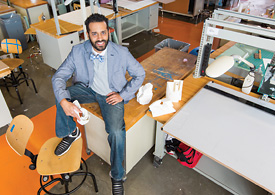
Photo by Eric Bronson, Michigan Photography.
Behind every structure, too and space is an architect who designed it, based on the needs of the user.
This is the work of U. Sean Vance.
Vance has been an assistant professor of architecture at the Taubman College of Architecture and Urban Planning since Fall 2010, after teaching at North Carolina State for four years.
Vance teaches two levels of undergraduate studios, a construction course, and a course on universal design. The focus of his research, practice and teaching is divided into three areas: construction, spatial cognition and design health.
The last area of focus, design health, is what drives most of his research. Vance is one of three professors leading the new Master’s in Design Health program. Part of his research has been working with the Medical Innovation Center on the ISObed, a cart designed to transport pediatric neuroblastoma patients within the medical center during their treatment, when the patient is radioactive for a period of up to five days and is dangerous to doctors and family members.
What moment in the classroom stands out as the most memorable?
The five seconds before I introduce myself. Every year. I’m nervous, I’m excited, the students are anticipating everything about what the course will be. The rawness of that moment.
What can’t you live without?
I’m trying to avoid saying it, but my cell phone. It’s my scheduler.
What are your favorite spots near campus?
Mani Osteria, a restaurant in town. It’s a great place to eat and a great atmosphere.
What inspires you?
The quality of space. The ability of emptiness to move us and inspire us.
What are you currently reading?
A 12,000-book comic collection. I’ll never read them all, but I at least want to categorize them.
Who had the greatest influence on your career path?
My mother. She never stops pushing me to exceed my current belief on potential. Everybody has a moment in their life where they fall, and every time I feel somebody push me back up, it’s her.
Vance appreciated how the doctors were aware of problems in the hospital setting and that they were striving to fix them.
“I was really excited to hear that,” he says. “I’m a multidisciplinary designer, in that I am a licensed architect, but I like to address things at a variety of scales.”
Another aspect of his interest in design health is the ability to help people through his work, particularly when designing for varying physical limitations.
“I’m interested in the role that the architect plays in improving health and safety for their environment,” Vance says. “Disability embodies a lot of things. It is not only the physical limitations of persons, but also the cognitive limitations.”
Architects are interested in what can be solved through architecture.
“We cannot exclude persons because of their physical limitations, the value of architecture is that it does reflect upon people’s needs to improve the conditions that surround us,” Vance says.
When all is said and done, though, Vance believes that architecture is an avenue for him to continue his passion for designing and drawing.
“I enjoy the feel of pen and paper,” he says. Architecture “was a way in which I could continue the excitement and feel of seeing and drawing, further into my life, and have it produce something.”
The weekly Spotlight features faculty and staff members at the university. To nominate a candidate, please contact the Record staff at [email protected].

